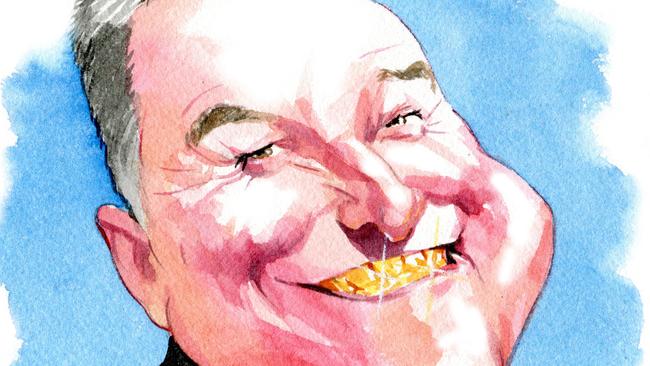ACCC sees shiny side of Apple Pay argument against banks
The ACCC has concluded Apple’s pay options are more likely to increase competition in banking than hurt it.

Three of the big four banks and Adelaide have sought ACCC approval to negotiate jointly with Apple but as expected they failed to satisfy the public interest test to make the move.
Apple, which accused the banks of being a “hard-core cartel”, has made clear even if the banks won authorisation it would simply say no, which makes the banks’ attempts at protecting their own patch look even more desperate.
This was a draft decision so the banks have another chance, but of course even if they manage to convince the regulator Apple has already made clear it will show the banks the door if they come as a unit or even individually unless they play by its rules.
The final decision will be issued in March.
The aim of the game for the banks is to protect customers from escaping via an alternative payment system and the banks, with the exception of ANZ, are prepared to go to any lengths possible to avoid losing customer control.
This tells you something about their mindset and explains why there is uproar against the banks, because in this case alone they have demonstrated an extraordinary preparedness to put their own revenues ahead of their customers’ free choice.
They want to put their technology on Apple phones so when you the use a phone as a payment device you go directly to the bank technology and bypass Apple.
ANZ has agreed to play the game the Apple way and in doing so has picked up some 100,000 new customers via Apple.
By letting Apple have some of its interchange fee, ANZ has let its customers choose whatever payments system they want and it seems the move has been a stunning success for the bank.
The other banks note the rival handset manufacturers allow open access, which would benefit everyone.
They have a point, but the main aim is to extend their market power to the new payments technology and question then how competition is encouraged.
Apple has shown with other applications like music it eventually opens the door to competing users like Spotify, which competes with iTunes. It has done the same with fingerprint identification technology and with Google Maps, which compete with Apple Maps on Apple devices.
The point being Apple is competing in the handset market so it too has to be wary of the potential impact of losing customers if they get sick of its closed system.
This is a balancing act but Apple as the owner of the technology gets to set the terms and the banks can’t dictate terms to it.
The banks claim Apple gets a free kick on the payments system because its payments use the system to get to the declared bank.
This movement would come at a cost to the user, which means the banks are compensated.
Apple claims the banks’ move would hurt the security and simplicity of its pay platform.
It notes that 3500 issuers in 12 countries are happy to play by the Apple rules.
Bonuses draw strikes
This annual meeting season has seen five top 100 companies — AGL, CSL, CBA, Goodman and Boral — cop 25 per cent-plus votes against their remuneration reports compared with a combined five strikes from the previous two years.
The issues centred on overpayment amid a period of generally weaker performance, including short-term bonuses that didn’t reflect performance.
In part this is because some bonuses are paid partly for non-financial reasons, which are more subjective.
Certainly, shareholders are in no mood to let overpayment through to the keeper in these slow growth times.
Last throw of the dice
AMP boss Craig Meller has responded to market demands for action over what he admits is an overly slow response to its life insurance problems.
The reality facing Meller is he runs one of the best brands in Australia and somehow the company just isn’t living up to its promise. The $14.6 billion AXA acquisition has not added the boost Meller had hoped for when he ran the integration process for former boss Craig Dunn.
Arguably, the market is undervaluing the company but that is a function of the way it’s being managed. In this context the radical management restructure unveiled yesterday is almost the last throw of the dice for Meller, who has held the reins for three years now, which is more than enough time to set his stamp on the place.
Meller is on record admitting his response to the life insurance problems has been too slow and gone yesterday was Pauline Blight-Johnston, who had primary responsibility for the area.
Also out the door are former Westpac banker Rob Caprioli and Wendy Thorpe, who has brought forward her retirement.
Into the spotlight comes former ANZ banker and long-time chief customer officer at AMP, Paul Sainsbury, who takes charge of all the cash-generating parts of the empire.
The rationalisation of wealth management and product solutions under one boss makes sense and means Sainsbury is now directly in the firing line if the till isn’t ticking over fast enough.
It doesn’t make much sense having one of the best brands in town if you’re not milking the proceeds, and frankly that’s been AMP’s problem even if its now much-vaunted North platform is showing the sort of promise the ACCC held out for it in the battle for AXA.
Sally Bruce is the new head of one of the star divisions, the AMP bank, which has increased earnings by 68 per cent over the past three years.
Operating earnings in the last half jumped 18 per cent to $59 million, with loans up 3 per cent to $16.6bn and deposits jumping 10 per cent to $11.8bn.
This is a reflection of the brand being well managed and by putting her foot on the accelerator Bruce could start to worry the mainstream banks.
Megan Beer gets line responsibility for insurance, which again is a sensible rationalisation.
In all, Meller has 11 direct reports, 45 per cent of whom are female, which puts him near the top of the class in corporate Australia.
Bank chair Catherine Brenner has backed Meller but acknowledges that some shareholders are restless, so the game now is to lift response times and to walk a bit on the wild side to exploit the company’s brand power.
The market hardly reacted, with the shares trading up slightly at $4.76, well down from the 52-week high last year of $5.98.
No sweat for gym deal
The ACCC tomorrow is expected to approve private equity group Quadrant’s $280m purchase of the Fitness First chain, clearing the way for the creation of Australia’s biggest privately owned gym group.
Quadrant also controls Goodlife Health Clubs (which it acquired from Ardent Leisure for $260m), Jetts Fitness and body slimming group Hypoxi. In all, it has 650,000 members and revenue of about $400m.
Fitness First was sold by another private equity firm, Oaktree.







The ACCC has concluded Apple’s pay options are more likely to increase competition in banking than hurt it and has rejected an attempt by the big banks to jointly negotiate a deal with the behemoth.